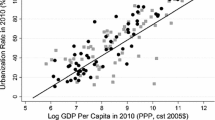Abstract
We introduce a Bayesian hierarchical regression model that extends the traditional least-squares regression model used to estimate gravity or spatial interaction relations involving origin-destination flows. Spatial interaction models attempt to explain variation in flows from n origin regions to n destination regions resulting in a sample of N = n 2 observations that reflect an n by n flow matrix converted to a vector. Explanatory variables typically include origin and destination characteristics as well as distance between each region and all other regions. Our extension introduces latent spatial effects parameters structured to follow a spatial autoregressive process. Individual effects parameters are included in the model to reflect latent or unobservable influences at work that are unique to each region treated as an origin and destination. That is, we estimate 2n individual effects parameters using the sample of N = n 2 observations. We illustrate the method using a sample of commodity flows between 18 Spanish regions during the 2002 period.





Similar content being viewed by others
Notes
For our conventional spatial contiguity matrix D which has zeros on the diagonal and row sums of unity, the inverse is well defined for ρ < 1.
Of course for the destination effects parameters, we have: ϕ = (I n − ρ d D)−1 u d .
Row sums of unity and zeros on the main diagonal.
Of course, one of the regions would need be eliminated from each of the matrices V, W to avoid have a perfect linear combination of dummy variables.
For clarity of presentation, we set forth conditional distributions involved in our sampling scheme in vector-matrix notation rather than the moment matrix form.
We exclude the intraregional model from the data generating process as well as estimation procedure.
References
Ballester C, Calvó-Armengol A, Zenou Y (2006) Who’s who in networks. Wanted: the key player. Econometrica 74:1403–1417
Banerjee S, Gelfand AE, Polasek W (2000) Geostatistical modelling for spatial interaction data with application to postal service performance. J Stat Plan Inference 90:87–105
Barry RP, Pace RK (1997) Kriging with large data sets using sparse matrix techniques. Commun Stat Comput Simul 26:619–629
Besag JE, York JC, Mollie A (1991) Bayesian image restoration, with two applications in spatial statistics. (with discussion). Ann Inst Stat Math 43:1–59
Besag JE, Kooperberg CL (1995) On conditional and intrinsic autoregressions. Biometrika 82:733–746
Bonacich PB (1987) Power and centrality: a family of measures. Am J Sociol 92:1170–1182
Cressie N (1995) Bayesian smoothing of rates in small geographic areas. J Reg Sci 35:659–673
Fischer MM, Scherngell T, Jansenberger E (2006) The geography of knowledge spillovers between high-technology firms in Europe evidence from a spatial interaction modelling perspective. Geogr Anal 38(3):288–309
Gelfand, Baerjee (2004) Hierarchical modeling and analysis for spatial data. Chapman & Hall/CRC, Boca Raton
Gelfand AE, Sahu S, Carlin BP (1995) Efficient parameterizations for normal linear mixed models. Biometrika 82(3):479-488
LeSage JP, Fischer MM, Scherngell T (2007) Knowledge spillovers across Europe, evidence from a poisson spatial interaction model with spatial effects. Pap Reg Sci 86(3):393–421
LeSage JP, Pace RK (2008) Spatial econometric modeling of origin-destination flows. J Reg Sci 48(5):941–967
Llano C (2004) Economía espacial y sectorial: el comercio interregional en el marco input-output. Instituto de Estudios Fiscales. Investigaciones 1-2004
Llano C, Esteban A, Pulido A, Prez J (2010) Opening the interregional trade black box: the C-intereg database for the Spanish economy (1995–2005). Int Reg Sci Rev 33:302–337
Oliver J, Luria J, Roca A, Prez J (2003) en La apertura exterior de las regiones en España: Evolución del comercio interregional e internacional de las Comunidades Autónomas. 1995–1998. Institut dÉstudis Autonòmics. Generalitat de Catalunya. Ed Tirant lo Blanch. Valencia
Sen A, Smith TE (1995) Gravity models of spatial interaction behavior. Springer, Heidelberg
Smith TE, LeSage JP (2004) A Bayesian probit model with spatial dependencies. In: LeSage JP, Kelley Pace R (eds) Advances in econometrics: volume 18: spatial and spatiotemporal econometrics. Elsevier Ltd, Oxford, pp 127–160
Sun D, Tsutakawa RK, Speckman PL (1999) Posterior distribution of hierarchical models using car(1) distributions. Biometrika 86:341-350
Sun D, Tsutakawa RK, Kim H, He Z (2000) Bayesian analysis of mortality rates with disease maps. Stat Med 19:2015–2035
Tiefelsdorf M (2003) Misspecifications in interaction model distance decay relations: a spatial structure effect. J Geogr Syst 5:25–50
Author information
Authors and Affiliations
Corresponding author
Appendix: Details regarding the MCMC sampler
Appendix: Details regarding the MCMC sampler
First, we show that the conditional posterior for δ takes the multivariate form presented in the text.
where as reported in the text:
In this appendix, we follow Smith and LeSage (2004) in deriving the conditional posterior for the spatial autoregressive effects parameters θ. They note that:
from which it follows that:
The conditional posteriors for σ 2 o , σ 2 d :
Which is proportional to the inverse gamma distribution reported in the text. A similar approach leads to \(p(\sigma^2_d | \ldots), \) and the conditional posterior for \(\sigma^2_{\varepsilon}: \)
Rights and permissions
About this article
Cite this article
LeSage, J.P., Llano, C. A spatial interaction model with spatially structured origin and destination effects. J Geogr Syst 15, 265–289 (2013). https://doi.org/10.1007/s10109-013-0181-8
Received:
Accepted:
Published:
Issue Date:
DOI: https://doi.org/10.1007/s10109-013-0181-8
Keywords
- Commodity flows
- Spatial autoregressive random effects
- Bayesian hierarchical models
- Spatial connectivity of Origin-destination flows




